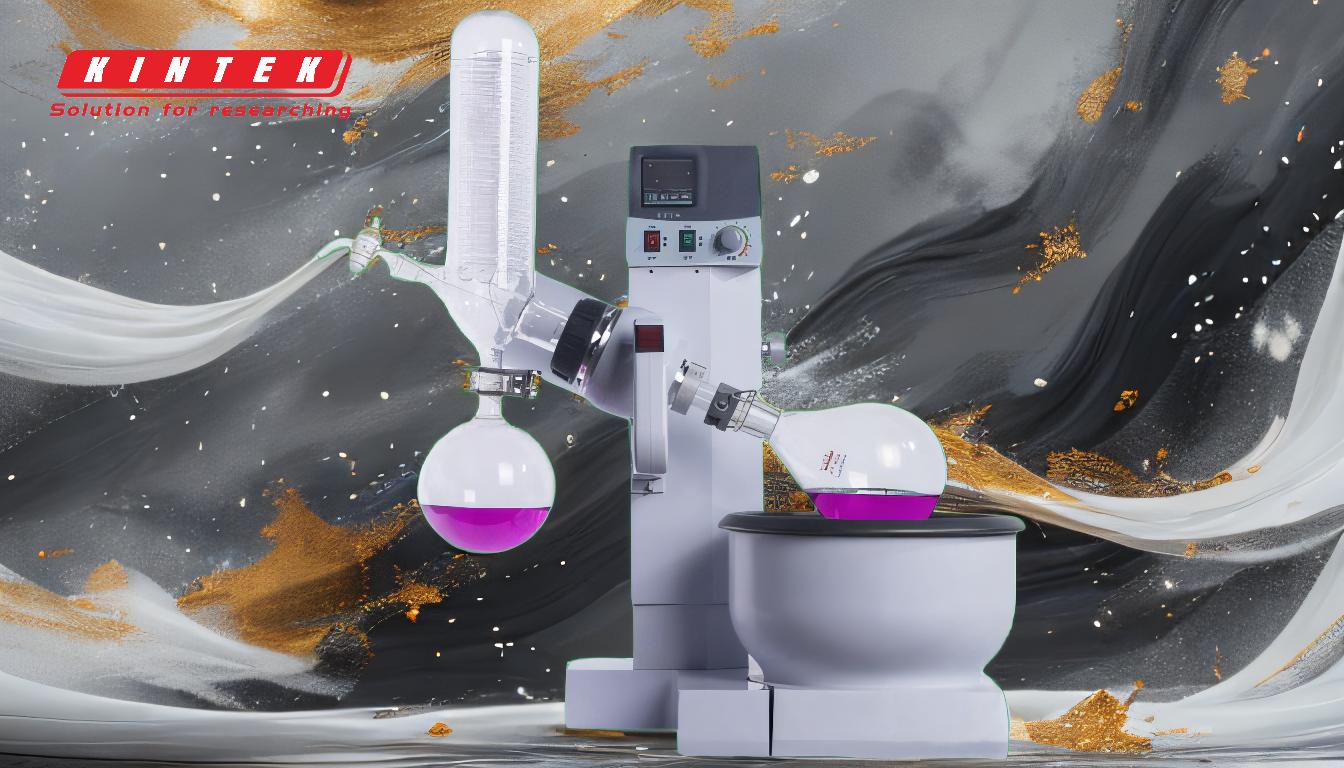A rotary evaporator is a laboratory device used to efficiently and gently remove solvents from samples through evaporation under reduced pressure. Its working principle revolves around the combination of reduced pressure (vacuum), controlled heating, and constant rotation of the evaporation flask. By lowering the internal pressure, the boiling point of the solvent is significantly reduced, allowing evaporation at lower temperatures. The rotation of the flask creates a thin film of the sample on the inner walls, increasing the surface area for evaporation and ensuring uniform heating. The evaporated solvent is then condensed and collected in a separate flask, while the concentrated sample remains in the original flask. This process is particularly useful for heat-sensitive materials and volatile solvents, as it minimizes thermal degradation and speeds up the evaporation process.
Key Points Explained:

-
Reduced Pressure (Vacuum) Principle:
- The rotary evaporator operates under reduced pressure, typically achieved using a vacuum pump or water aspirator.
- Lowering the pressure inside the system reduces the boiling point of the solvent, enabling evaporation at lower temperatures.
- This is particularly beneficial for heat-sensitive materials, as it prevents decomposition or alteration of the sample's properties.
- For example, solvents like dimethylformamide (DMF) and dimethyl sulfoxide (DMSO) can be distilled at significantly lower temperatures (e.g., 50°C) under a vacuum of 5 torr compared to their atmospheric boiling points.
-
Rotation Mechanism:
- The evaporation flask is rotated at a constant speed, creating a thin film of the sample on the inner walls of the flask.
- This rotation increases the surface area of the solvent, enhancing the rate of evaporation.
- It also ensures uniform heating of the sample, reducing the risk of localized overheating or "bumping" (sudden, violent boiling).
- The rotating mechanism is especially useful for volatile and heat-sensitive materials, as it minimizes direct heat exposure and promotes gentle evaporation.
-
Heating System:
- The rotary evaporator uses a heated water or oil bath to provide controlled and consistent heating to the evaporation flask.
- The temperature of the bath is carefully regulated to match the reduced boiling point of the solvent under vacuum conditions.
- This ensures efficient evaporation without overheating the sample.
-
Condensation and Collection:
- As the solvent evaporates, the vapor travels through a vapor duct or tube into a condenser.
- The condenser, typically cooled by a circulating coolant (e.g., water or refrigerant), cools the vapor back into a liquid state.
- The condensed solvent is then collected in a separate receiving flask, while the concentrated sample remains in the original evaporation flask.
-
Applications and Advantages:
- Rotary evaporators are widely used in chemistry, pharmaceuticals, and food science for solvent removal, concentration, and purification.
- The system is highly efficient, allowing for rapid evaporation of solvents with minimal thermal stress on the sample.
- It is particularly useful for processing heat-sensitive compounds, such as natural products, polymers, and biological materials.
-
System Components:
- Evaporation Flask: A round-bottomed flask that holds the sample and rotates to create a thin film.
- Condenser: A cooling unit that condenses the evaporated solvent back into liquid form.
- Receiving Flask: Collects the condensed solvent after it passes through the condenser.
- Vacuum Pump: Reduces the pressure inside the system to lower the boiling point of the solvent.
- Heating Bath: Provides controlled heating to the evaporation flask.
- Rotation Motor: Drives the rotation of the evaporation flask to enhance evaporation efficiency.
By combining these principles and components, the rotary evaporator provides a reliable and efficient method for solvent removal, making it an indispensable tool in many laboratory settings.
Summary Table:
| Key Feature | Description |
|---|---|
| Reduced Pressure | Lowers solvent boiling point, enabling evaporation at lower temperatures. |
| Rotation Mechanism | Creates a thin film of the sample, increasing surface area for faster evaporation. |
| Heating System | Provides controlled heating to match the reduced boiling point of the solvent. |
| Condensation & Collection | Condenses evaporated solvent into a separate flask for recovery. |
| Applications | Ideal for heat-sensitive materials, pharmaceuticals, and food science. |
| Components | Includes evaporation flask, condenser, vacuum pump, heating bath, and motor. |
Discover how a rotary evaporator can optimize your lab processes—contact us today for expert advice!











